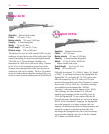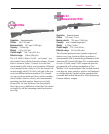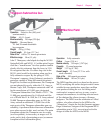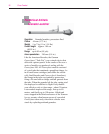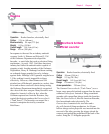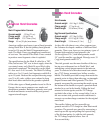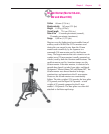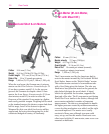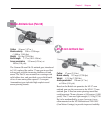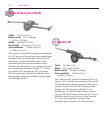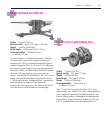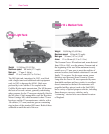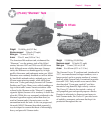
98
Close Combat
German Hand Grenades
Stick Grenade
Grenade weight
0.61 kg (1.36 lb)
Charge weight
.17 kg (6 oz)
Overall length
355.6 mm (14 in.)
Egg Grenade Specifications
Grenade weight
0.23 kg (0.5 lb)
Charge weight
0.115 kg (0.25 lb)
Overall length
134.6 mm (5.3 in.)
As they did with almost every other weapons type,
the Germans developed a number of different hand
grenades. There were, however, two primary types of
German high-explosive hand grenades: the
Stielhandgranate 24 (“stick hand grenade, model
24”), and the smaller, egg-shaped Eihandgranate 39
(“egg hand grenade model 39”).
The stick grenade was the more familiar of the two,
having seen widespread use in World War I, and
undergoing various improvements in the interwar
years. It consisted of a thin sheet-metal can contain-
ing a TNT charge, mounted on a hollow wooden
handle. The handle provided leverage that made this
grenade easier to throw than other egg- or pineapple-
shaped German and Allied grenades. The stick
grenade was armed by unscrewing the metal cap on
the bottom of the handle to expose a porcelain bead
attached to a cord in the handle. Pulling the bead
actuated a friction igniter, and the TNT charge
exploded after a four- to five-second delay. Late in
the war variant stick grenade models substituted a
concrete or wooden charge container for the original
metal head.
The smaller, lighter, and less powerful egg
grenade encased a TNT charge in a thin sheet-metal
container. The grenade was armed by unscrewing a
metal cap on the top and pulling the exposed ring
of the friction igniter. As with the stick grenade,
the TNT charge exploded after a four- to
five-second delay.
American Hand Grenades
Mark II Fragmentation Grenade
Grenade weight
.59 kg (21 oz)
Charge weight
.14 kg (5 oz)
Overall length
139.7 mm (5 in.)
Range
45 m (50 yds) maximum
American soldiers used many types of hand grenades
during World War II, but the primary hand grenade
issued to GIs was the Mark II fragmentation gre-
nade. The Mark II was egg-shaped and constructed
of cast iron. The outside of the Mark II was serrated
to produce more fragments when it exploded.
The specifications for the Mark II called for a TNT
filler, but because TNT was in short supply when the
war started, many early Mark IIs were filled with a
nitrostarch compound. The time delay on the Mark
II’s fuse was 4 to 4.8 seconds. The Mark II’s killing
radius was 5 to 10 yards, but fragments could kill at
up to 50 yards. Because the accepted throwing range
was 35 to 40 yards, soldiers were ordered to keep
their heads down until after the grenade exploded.
Of the other types of hand grenades issued to GIs in
Europe, the two most common were smoke and
phosphorus grenades. Both these grenades were used
to mask movements or mark artillery and ground-
support aircraft targets.



